
In his book, The Reform of the Liturgy 1948-1975, the architect of the reform that took place after the Second Vatican Council, Annibale Bugnini, expressed his regret that he could not move Ash Wednesday onto a Sunday. A penitential Sunday is impossible, he explains, but as things stand, Ash Wednesday is forever associated with Mardi Gras.
In countries and regions where Mardi Gras is a big thing, one can appreciate the problem, especially when celebrations spread over Ash Wednesday itself. And yet, like the consumerism of Christmas present-giving and the chocolate eggs of Easter, it is ultimately a product of Catholic liturgy. As Catholics, we have to work out how to handle this overgrown and frankly deformed progeny of our own tradition.
We have a similar problem with Halloween.
The Eve of All Hallows, that is to say the feast of All Hallowed (Holy) Souls, or All Saints, Hallowe’en, is the day before All Hallows, All Saints. As one of the major feasts of the Church’s year, All Saints is a holy day of obligation, and until the reforms of 1955, it had both a vigil and an octave. The octave meant that the same Mass, the Mass of All Saints, would be celebrated again on the eighth day, and sometimes on intervening days. The vigil Mass, with its own prayers and readings, was celebrated the day before. This arrangement made possible, for the greatest feasts of the Church’s year, repeated opportunities to contemplate the mystery expressed in the feast and, in the case of the vigil, an opportunity to contemplate it in a penitential mode, before celebrating it as a joyful feast. For the vigil was a penitential day: violet vestments were worn, and the 1917 Code of Canon Law listed the Vigil of All Saints as a fast day.
All Hallows also introduced a month of special prayers for the dead. The Commemoration of the Faithful Departed, All Souls, came to be celebrated on the following day, and has with Christmas Day alone the distinction of having three different Masses that can be said. This is a reminder that priests have the privilege of celebrating three Masses on those two days, whereas for the rest of the year, they can celebrate only one unless there is pastoral need.
The combination of the penitential anticipation of All Saints and the days following dedicated to the not yet holy dead quite naturally raises an association with graveyards and ghosts. First, as the texts of the vigil remind us, the prospect of the glory of the saints should remind us of our own coming death and our need for repentance. Second, the Catholic view is that ghosts are the spirits of those in Purgatory who are allowed to visit their families and the places associated with them in life in order to remind the living to pray for them. Third, the liturgy of these days is all about the transition from the state of earthly life and of Purgatory to the beatific vision of the blessed in heaven—the journey of the soul from one state to another.
A problem arises when cultural customs informed by Catholicism are inherited by societies that officially reject Catholic theology. The hero of Shakespeare’s Hamlet has to decide if his father’s ghost is, as the ghost itself claims, a soul in Purgatory, as Catholics would have it, or a devil in disguise, as Protestant theologians claimed, on the basis that Purgatory does not exist and ghost stories have to be explained somehow:
Be thou a spirit of health or goblin damn’d,
Bring with thee airs from heaven or blasts from hell,
Be thy intents wicked or charitable.
Protestantism transformed Halloween’s unquiet spirits from ultimately benign, if alarming, reminders of our mortality to evil spirits seeking our spiritual destruction. This has made Halloween into something far darker and more menacing than it was intended to be.
Today we have to deal with another layer of misunderstanding: the attempt by neo-pagans to claim Halloween for their own. Neo-pagans have re-purposed the arguments of sixteenth-century Protestants, that Catholicism was a kind of pagan superstition, and the claims of early twentieth-century antiquarians, that things about medieval Catholicism that look a bit odd to secularized Anglicans must necessarily be hang-overs from a pre-Christian past. For the neo-pagans, Easter, “Yule” (Christmas), and “Samhein” (Halloween) are things Christians stole from paganism, and which pagan revivalists alone understand and appreciate.
This claim is almost entirely without any historical basis. Pre-Christian Celts and others may well have had some kind of harvest festival, but the celebration of All Saints came from Rome, not the Celtic world, and everything about it makes sense in terms of Catholic theology and culture. If there is any cultural appropriation going on, it is of the Catholic understanding of ghosts and fallen angels, which is mangled and commercialized with scant regard for our sensitivities.
The problem remains, as Bugnini mused about Mardi Gras: one of the key moments in the Church’s calendar has been overlaid by something tacky, and occasionally grossly offensive and unchristian. One is caught between Bugnini’s own instinct, that if it were possible, it would be better to move our own celebration elsewhere and let the modern world do what it wants, and a desire to re-Christianize something that has long lost its Christian meaning.
Exactly how the latter strategy could work would depend on the precise cultural practices one is dealing with. In some countries—and this is a sufficient reason to reject the first strategy of just giving up on it all—the cult of the dead is still a powerful social reality. People do actually visit their loved ones’ graves at this time. What we need to do is to strengthen the spiritual motivation of what remains of healthy Catholic culture and, if nothing much remains, at least to fortify our personal response, as Catholics, to what the Church is asking of us at this time of year.
The Church’s message was not strengthened by the abolition of the Halloween Vigil of All Saints in 1955. The sense that this reform, in which eleven vigils were abolished, leaving only four, was excessive is widespread. (One of the abolished vigils, of Epiphany, was actually restored, in a fashion, in the post-Vatican II Missal.) The importance of a feast is marked by the preparation we make for it: Easter by Lent, Christmas by Advent. If we want to take All Saints seriously as the triumph of the Church in her saints over persecution and all the forces of darkness, then a single day of mild penance, a Halloween with its own Mass, seems entirely appropriate.
In the meantime, there remain things for us to do: taking the celebration of All Saints and All Souls as seriously as possible, and resisting the suggestion that there is no need to pray for the dead. They are helpless: they cannot do good works to mitigate their sins. In recognition of this fact, the official Handbook of Indulgences offers us indulgences applicable to the dead every day for the first eight days of November if we pray in a cemetery—plenary on the usual conditions. Let us not neglect this opportunity to help our loved ones, and also the forgotten dead who have no one to pray for them.



